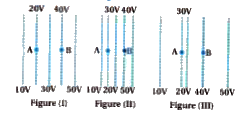Complete Solutions to Section C ( NCERT Exemplar Solution ) ( Multiple Choice Questions (MCQs ) ) of chapter ELECTROSTATIC POTENTIAL AND CAPACITANCE of Class 12 book with complete answers and questions
| Class 12 | PHYSICS |
| Chapter | ELECTROSTATIC POTENTIAL AND CAPACITANCE |
| KUMAR PRAKASHAN | Section C ( NCERT Exemplar Solution ) ( Multiple Choice Questions (MCQs ) ) |
| Number Of Questions | 13 |
| Academic Year | 2023-24 |
A capacitor of 4 `mu`F is connected as shown in the circuit as per figure. The internal resistance of the batlery is 0.5 `Omega`. The amount of charge on the capacitor plates will be:

(a) `0 mu C `
(b) `4 mu C `
(c) `16 muC `
(d) `8 mu C `
View SolutionA positively charged particle is released from rest in an unform electric field. The electric potential energy of the charge
View SolutionFigure shows some equipotential line distributed in space. A charged object is move from point A point B.

View SolutionThe electrostatic potential on the surface of a charged conducting sphere is 100V. Two statements arc made in this regard :
`S_(1)` : At any point inside the sphere, electric intensity is zero.
`S_(2)` : At any point inside the sphere, the ' electrostatic potential is 100V .
Which of the following is a correct statement ?
View SolutionEquipotential at a great distance from a collection of charges whose total sum is not zero are approximately
View SolutionA parallel plate capacitor is made of two dielectric blocks in series. One of the blocks has thickness `d_(1)` and dielectric constant `k_(1)` and the other has thickness `d_(2)` and dielectric constant `k_(2)` as shown in figure. This arrangement can be thought as a dielectric slab of thickness d = `( d_(1) + d_(2) )` and effective dielectric constant k. The k is ......

(a) `(K_(1)d_(1)+K_(2)d_(2))/(d_(1)+d_(2))`
(b) `(K_(1)d_(1)+K_(2)d_(2))/(K_(1)+K_(2))`
(c) `(K_(1)K_(2)(d_(1)+d_(2)))/((K_(1)d_(2)+K_(2)d_(1)))`
(d) `(2K_(1)K_(2))/(K_(1)+K_(2))`
View SolutionConsider a uniform electric field in the `hatz` direction. The potential is a constant
View SolutionEquipotential surfaces,
View SolutionThe work done to move a charge along equipotential from A to B
View SolutionIn a region of constant potential
View SolutionIn the circuit shown in figure initially key `K_(1)` is closed and key `K_(2)` is open. Then `K_(1)` is opened and `K_(2)` is closed (order is important ). Take `Q_(1)` and `Q_(2)` as charges on `C_(1)` and `C_(2)` and `V_(1)` and `V_(2)` as voltage respectively. Then,

(a) Charge on `C_(1)` gets redistributed such that `V_(1)-V_(2)`
(b) Charge on `C_(1)` gets redistributed such that `Q_(1)=Q_(2)`
(c) Charge on `C_(1)` gets redistributed such that `C_(1)V_(1)+ C_(2)V_(2)= C_(1)E`
(d) Charge on `C_(1)` gets redistributed such that `Q_(1)+Q_(2)=Q`
View Solutionlf a conductor has a potential V `ne` 0 and there are no charges anywhere else outside, then
View SolutionA parallel plate capacitor is connected to a battery as shown in figure .Consider two situations ,
(A) Key K is kept closed and plates of capacitors are moved apart using insulating handle.
(B) Key K is opened and plates of capacitors arc moved apart using insulating handle. Choose the correct optlons.
 ,
,
View Solution
Section C ( NCERT Exemplar Solution ) ( Multiple Choice Questions (MCQs ) ) questions and complete solutions for chapter ELECTROSTATIC POTENTIAL AND CAPACITANCE of KUMAR PRAKASHAN KENDRA PHYSICS (GUJRATI ENGLISH) of Class 12
All Exercises from KUMAR PRAKASHAN Class 12 PHYSICS ELECTROSTATIC POTENTIAL AND CAPACITANCE
- ( Section -A) Try Yourself
- ( Section -A) Questions - Answers
- Section B (questions)
- Section B ( Numerical From DARPAN. Based on Textbook )
- Section B ( Numerical From Textual Exercise )
- Section B Numericals
- Section C ( NCERT Exemplar Solution ) ( Long Answer Type Questions )
- Section C ( NCERT Exemplar Solution ) ( Multiple Choice Questions (MCQs ) )
- Section C ( NCERT Exemplar Solution ) ( Very Short ,Aswer Type Questions )
- Section C ( NCERT Exemplar Solution ) (Short ,Aswer Type Questions )
- Section D ( MCQs asked in Cometitive Exams )
- Section D ( Multiple Choice Questions (MCQs) )